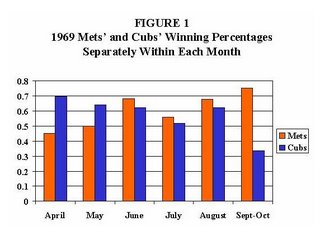My specialty on this blog is, of course, the
statistical analysis of sports streakiness. It has not been my intention to exclude other, non-statistical perspectives on hotness and coldness; I just haven't seen much of other genres.
Now, however, I've just finished reading the book
Confidence: How Winning Streaks & Losing Streaks Begin & End (
excerpt), by Harvard Business School professor Rosabeth Moss Kanter. The original hardcover version came out in 2004, but the paperback, which I read, just came out this year. Focusing on the worlds of business and sports, the book examines long-term failures, successes, and turnarounds from one to the other, through the lens of
organizational culture.
In the athletic realm, Kanter uses two women's collegiate teams,
North Carolina soccer and
UConn basketball, to present the most extensive case studies of winning cultures, the
Prairie View A&M football squad to illustrate a losing culture, and the Philadelphia Eagles' ascension to Super Bowl-quality in recent years to demonstrate positive turnaround. Dusty Baker's Chicago Cubs, who at the time of the book's initial publication looked to be turning around the franchise's longstanding losing ways (although they're not doing so at present), are discussed more briefly, as are several other teams.
What I take to be Kanter's major points are as follows:
*An organization's most visible results -- on the scoreboard or in financial data -- will tend to be reflected at a deeper level by other markers, such as a leader's communicative skills and ability to innovate (and spur innovation) and a team's work ethic, quality of facilities, community support, etc.
*Winning -- or losing -- can launch "chain reactions," thus perpetuating the original trend. Winning gets a team on television, helps attract better players (either through free agency in the pros or recruiting at the college level), builds fan support, etc., which fosters further winning, brings in money to improve facilities, etc. Losing sets the opposite types of events in motion.
*The ideal psychological environment for an organization seems to be one in which employees know they'll be held accountable for maintaining productive output, but feel supported enough that they will be comfortable taking risks, innovating, and reaching out to colleagues in a collaborative spirit. Failure of a promising idea to bear fruit will not trigger a cycle of criticism and blame, but rather a coming together of employees to improve the next time.
These ideas certainly seem valid. The tricky part -- which Kanter readily acknowledges -- is in untangling the causality. Yes, a positive attitude (or nice facilities or fan support) can help a team win, but winning will also likely promote a positive attitude (and the ability to construct new facilities and to attract fans).
Implementing Kanter's suggestions could well spur a winning streak, but even if a team doesn't end up winning as much as it had hoped, the changes could still be a net positive. One example I've thought of is that a university that attempts to improve its national academic ranking by building a new libary, will still have a nice new library, regardless of what happens with the rankings. Ultimately, however, there are no guarantees. I suspect there are many sports teams Kanter did not talk about that work hard in practice, assess player performance via objective "metrics," have nice facilities -- and still lose.
Statistical hot-hand research, that is, whether outcomes of successive trials on sports tasks are independent or not, is discussed occasionally in the book -- including citation of the Gilovich et al. study and a reference to Duke men's basketball coach Mike Krzyzewski's philosophy that players should always focus on the "next play," without carrying over any reaction from the previous one (p. 351). Most of the book's subject matter deals with long-term trends, however, and not moment-to-moment performance.
At 380 pages, the book will require dedication from the reader. Many portions seemed redundant to me, and full of platitudes. Often, the text jumps from one team/organization to another. My favorite parts were the extended discussions of single case studies, such as Prairie View football, Continental Airlines, and Nelson Mandela's leadership in transforming South African society.
